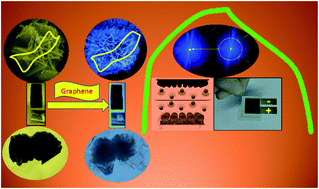A high-performance hybrid supercapacitor by encapsulating binder-less FeCoSe2 nanosheets@NiCoSe2 nanoflowers in a graphene network†
Abstract
Transition-metal selenides (TMSes) are gaining great attention in the energy storage sector. However, they usually suffer from poor cycling stability and low rate capacities because of their structural instability and easy aggregation during charge/discharge cycles. A general approach to overcome this obstacle is to construct TMSes by introducing carbonate materials such as graphene on the conducting substrate. In such a case, for the first time, a binder-less cathode electrode material derived from FeCoSe2 nanosheet@NiCoSe2 nanoflower nanoarrays encapsulated in the graphene network on a nickel foam substrate (FCS@NCS-G@NF) was rationally fabricated for hybrid supercapacitors. In such a structure, the FeCoSe2@NiCoSe2 (FCS@NCS) nanoarrays with a porous nature feature easy ion diffusion, plentiful electroactive sites, and adequate buffering space. Also, the wrapping of the graphene layer around FCS@NCS nanoarrays not only endows the nanostructures with higher conductivity but also prevents the aggregation of FCS@NCS nanoarrays and retains structural stability during long-term durability tests. Benefiting from such merits, the FCS@NCS-G@NF electrode features high specific capacity (1156 C g−1 at 1 A g−1) and superior rate performance (81% at 30 A g−1) together with impressive cycling durability (92.3% retention after 11 000 times charge/discharge at 10 A−1 g), which are better than those of the FCS@NCS@NF electrode. Besides, the resulting FCS@NCS-G@NF (+)‖activated carbon@NF (AC@NF)(−) hybrid supercapacitor achieves an energy density of 62.2 W h kg−1 at 800.5 W kg−1 and good longevity (∼90.8% retention over 11 000 cycles). These findings provide a straightforward strategy for the fabrication of various types of graphene encapsulated TMSes for supercapacitors.


 Please wait while we load your content...
Please wait while we load your content...